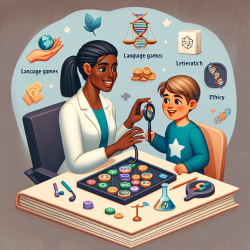The journey of enhancing communication skills in children diagnosed with acquired aphasia complicated by a convulsive disorder presents unique challenges and opportunities for practitioners. A compelling case study, detailed in the research article "Augmentative and Alternative Communication Intervention for a Child with Acquired Aphasia with Convulsive Disorder: A Case Study," offers invaluable insights into the assessment and intervention strategies that can significantly impact these children's lives.
Acquired aphasia with convulsive disorder is a rare condition that affects children, leading to the loss of previously acquired language skills due to seizure activity. This condition not only impacts the child's ability to communicate but also affects their social interactions and educational development. The case study of a seven-year-old boy, referred to as Michael, sheds light on the practical application of augmentative and alternative communication (AAC) systems to support and enhance communication for children facing similar challenges.
From the onset, Michael's case was complex due to the ongoing seizure activity and the severe impact on his expressive and receptive language abilities. The intervention focused on identifying and implementing an AAC system that would best support Michael's needs, taking into consideration his preferences, abilities, and the unique challenges posed by his condition. The case study highlights several critical aspects of working with children with acquired aphasia and convulsive disorder:
- Assessment and Selection of AAC Systems: The process involved a thorough assessment of Michael's communication skills, preferences, and motor abilities. This assessment was crucial in selecting an AAC system that was not only accessible to Michael but also effective in enhancing his communication. The use of a personalized graphic communication display, alongside gestures and existing speech approximations, proved to be a successful approach.
- Integration into Daily Activities: The AAC system's integration into Michael's daily activities was vital for its success. By incorporating the system into familiar and motivating activities, Michael was more likely to use and benefit from it. This approach emphasizes the importance of context and relevance in AAC intervention.
- Flexibility and Adaptation: Michael's case demonstrates the need for flexibility and adaptation in the use of AAC systems. The intervention adapted to Michael's changing interests, needs, and medical condition, highlighting the dynamic nature of AAC intervention.
- Collaboration: The successful implementation of the AAC system was a collaborative effort involving Michael's family, educators, and therapists. This collaboration ensured that the AAC system was consistently used across different environments, providing Michael with a coherent and supportive communication framework.
The case study of Michael provides a poignant reminder of the challenges faced by children with acquired aphasia and convulsive disorder. However, it also offers hope and a roadmap for practitioners looking to make a difference in these children's lives through the thoughtful application of AAC systems. By taking a holistic, flexible, and collaborative approach, practitioners can significantly enhance the communication abilities and overall quality of life for children like Michael.
For those interested in delving deeper into the strategies and outcomes of this intervention, I highly encourage reading the original research paper. To read the original research paper, please follow this link: Augmentative and Alternative Communication Intervention for a Child with Acquired Aphasia with Convulsive Disorder: A Case Study.










